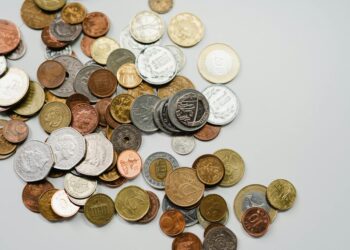Coins minted during King George V’s reign (1910-1936) are a significant part of British numismatic history and include a wide array of denominations, metals, and designs.
Here’s a look at some key aspects of George V coins:
The coinage of King George V included a range of denominations like the Sovereign, Half Sovereign, Crown, Halfcrown, Florin, Shilling, Sixpence, Threepence, Penny, Halfpenny, Farthing , and even the One Third Farthing.
- Gold: Gold Sovereigns and Half Sovereigns were prominent during his reign.
- Silver: Coins like the Halfcrown, Shilling, Florin, Sixpence, and Threepence were minted in silver, with the fineness reduced from 92.5% (Sterling Silver) to 50% in 1920 due to rising silver prices.
- Bronze: Pennies, Halfpennies, and Farthings were typically made of bronze.
- Portrait: The obverse of George V coins typically features the portrait of King George V, designed by Bertram Mackennal, facing left.
- Reverse Designs: The reverse of many George V coins, particularly the Gold Sovereigns, featured the iconic design of St. George and the Dragon by Benedetto Pistrucci. Other denominations featured different reverse designs, like crowned shields for some denominations.
- The “Pig Rupee”: An unusual variant from British India coinage during George V’s reign, these coins featured a redesigned elephant that mistakenly resembled a pig, making them sought-after collector’s items today.
- 1935 Silver Jubilee Crown: A special Crown with a unique “rocking horse” design by Percy Metcalfe was issued to commemorate George V’s Silver Jubilee (25 years on the throne). The edge inscription on this coin reads “DECUS ET TUTAMEN ANNO REGNI XXV,” meaning “An ornament and a safeguard 25 years of reign”.
- End of Gold Sovereign Circulation: George V’s reign marked the end of the gold Sovereign as a circulating coin due to the economic demands of World War I.
George V coins are popular among collectors due to their historical significance and variety. Some specific years and denominations are considered more valuable than others:
- 1935 George V Silver Crown: These Crowns were not intended for general circulation and are considered valuable.
- Scarce Silver Threepences: Threepence coins from specific years like 1925, 1926, 1928, and 1930 are relatively scarce and sought after by collectors.
- Uncirculated Pennies: Uncirculated examples of George V pennies are harder to find than circulated ones.
- King George V was known for his dedication to Great Britain and had a particular interest in philately (stamp collecting).
- He also started the tradition of the Royal Christmas broadcast in 1932.
If you’re interested in collecting George V coins, it’s recommended to research specific denominations and years to determine their rarity and value. You can find various resources online or consult with coin dealers and experts.











What is a Georgivs V coin?
From my experience, George V Farthing date set 1911-36
These are the lowest denomination bronze coin that was regularly struck during his reign. They go from the Coronation issue of 1911 until the year of his death 1936.
Which George coins are valuable?
George VI coins
The most valuable coins from King George VI’s reign are the Gold Sovereigns and Half Sovereigns that were struck in 1937 as part of a four coin set to celebrate his coronation. The design showed Pistrucci’s St George and the Dragon on the reverse and Humphrey Paget’s portrait of the King on the obverse.
How much is a King George V penny worth?
Great question! Arguably the most valuable one penny coin is the 1933 George V penny, which is worth an estimated value of £72,000. Although this was originally created as a pattern coin – which means it is not intended for release into circulation – it is believed seven were issued, making them extraordinarily rare.